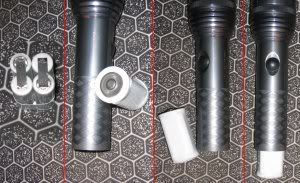the danger with parallel charging NiMH or NiCd happens when u charge past the peak.
no matter how closely matched, one of the cells out of the parallel group will always reach peak first.
it's after peaking where its voltage drops that's the big problem which prevents the others from reaching their peak all the while continually diverting all the current that is supposed to be shared equally.
until it finally overheats & vents while endlessly waiting for the remaining cells to fill up.
to parallel charge safely one simple way is to charge reely, reely slo.
so slo that if one cell does hog the current meant for all of them it still doesn't exceed the max trickle charge of a single cell.
that would make for something like a 50 hour rate so for a fast charge u need to terminate well b4 any cell can reach its peak.
this means -dv/dt can't be used at all which is really what all the dire warnings against parallel charging NiMH/NiCd are targeting.
to allow for fast and safe parallel charging it's likely Sanyo will opt for dT/dt (having them thermally equalized housed within the same small container certainly helps) altho dv²/dt might work too.
a slight reduction in capacity by not filling to the brim is the only trade-off for the improved reliability & longevity.
i think negative deltaV charging is generally damaging to NiMH cells anyways, parallel or not.
now plug in 2500 mAh for the Eneloop XX.
everyone raise their hand, who can use a 17 Ah LSD or 20 Ah super lattice D cell?
then try & tell me there's no market for hi cap D cells.
i hoping when the Chevron patents expire in a couple more years that prevent anyone from manufacturing large high density NiMH cells that Sanyo will still be interested in producing a true D size Eneloop.
no matter how closely matched, one of the cells out of the parallel group will always reach peak first.
it's after peaking where its voltage drops that's the big problem which prevents the others from reaching their peak all the while continually diverting all the current that is supposed to be shared equally.
until it finally overheats & vents while endlessly waiting for the remaining cells to fill up.
to parallel charge safely one simple way is to charge reely, reely slo.
so slo that if one cell does hog the current meant for all of them it still doesn't exceed the max trickle charge of a single cell.
that would make for something like a 50 hour rate so for a fast charge u need to terminate well b4 any cell can reach its peak.
this means -dv/dt can't be used at all which is really what all the dire warnings against parallel charging NiMH/NiCd are targeting.
to allow for fast and safe parallel charging it's likely Sanyo will opt for dT/dt (having them thermally equalized housed within the same small container certainly helps) altho dv²/dt might work too.
a slight reduction in capacity by not filling to the brim is the only trade-off for the improved reliability & longevity.
i think negative deltaV charging is generally damaging to NiMH cells anyways, parallel or not.
Mr Happy said:The capacity of a cell is roughly proportional to its internal volume.
Therefore, we can estimate:
Volume(AA) = π/4 · 14.5² · 50 = 8300 mm³
Capacity(AA) = 1900 mAh
Volume(D) = π/4 · 34² · 61 = 55,000 mm³
Capacity(D) = 550/83 · 1900 = 13,000 mAh
We find D size NiMH cells with capacities up to 12,000 mAh, so this estimate stacks up.
now plug in 2500 mAh for the Eneloop XX.
everyone raise their hand, who can use a 17 Ah LSD or 20 Ah super lattice D cell?
then try & tell me there's no market for hi cap D cells.
i hoping when the Chevron patents expire in a couple more years that prevent anyone from manufacturing large high density NiMH cells that Sanyo will still be interested in producing a true D size Eneloop.



